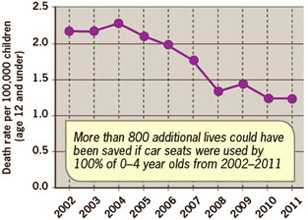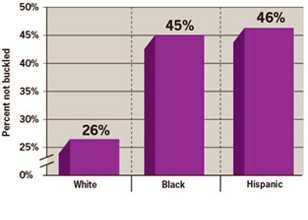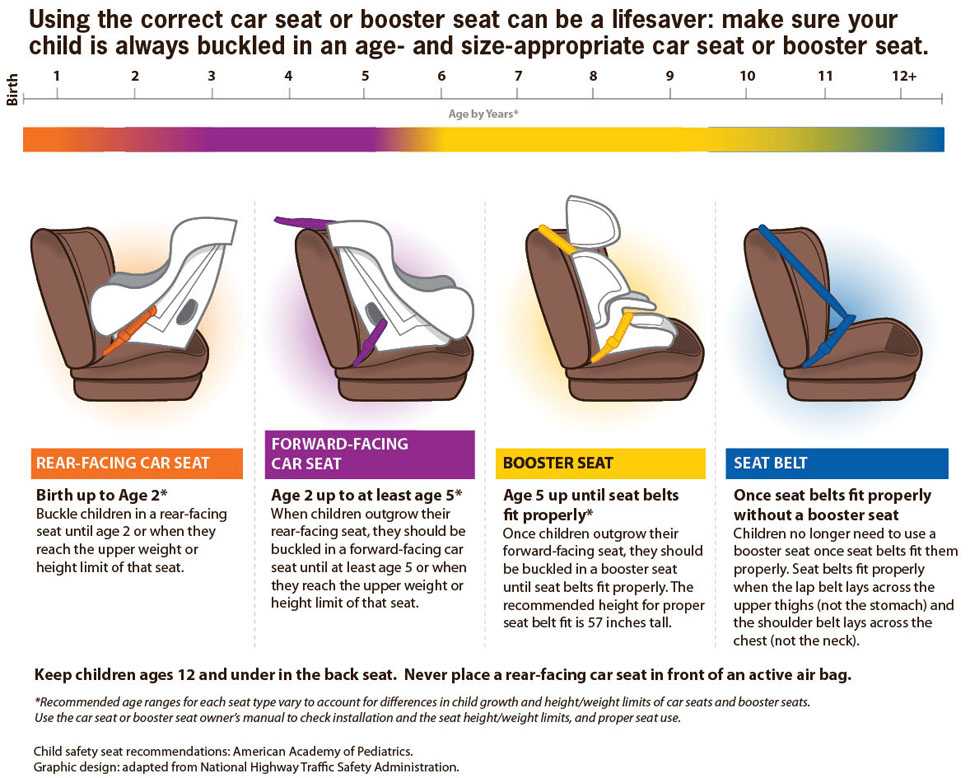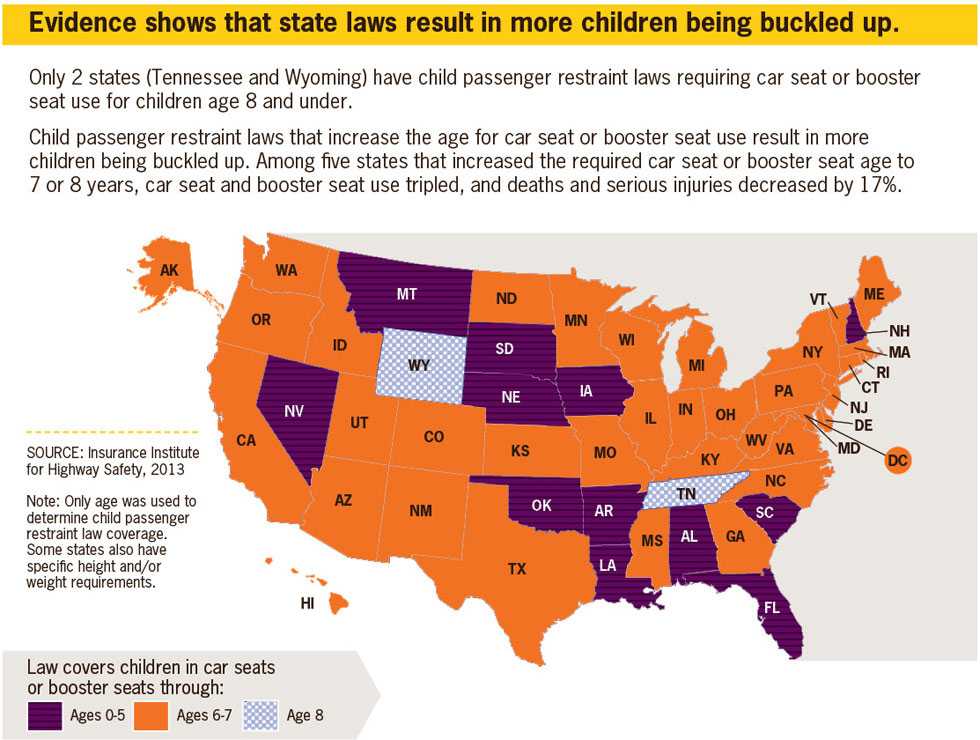Child Passenger Safety Infographics
This map of the United States shows the age through which each state’s child passenger restraint law covering car seat or booster seat use applies, whether age five, ages 6-7, or age 8. The required age for each state is as follows:
Ages required by state law to use a car seat or booster seat
- Alabama — aged 5 or younger
- Alaska — aged 7 or younger
- Arizona — aged 7 or younger
- Arkansas — aged 5 or younger
- California — aged 7 or younger
- Colorado — aged 7 or younger
- Connecticut — aged 6 or younger
- Delaware — aged 7 or younger
- Florida — aged 3 or younger
- Georgia — aged 7 or younger
- Hawaii — aged 7 or younger
- Idaho — aged 6 or younger
- Illinois — aged 7 or younger
- Indiana — aged 7 or younger
- Iowa — aged 5 or younger
- Kansas — aged 7 or younger
- Kentucky — aged 6 or younger
- Louisiana — aged 5 or younger
- Maine — aged 7 or younger
- Maryland — aged 7 or younger
- Massachusetts — aged 7 or younger
- Michigan — aged 7 or younger
- Minnesota — aged 7 or younger
- Mississippi — aged 6 or younger
- Missouri — aged 7 or younger
- Montana — aged 5 or younger
- Nebraska — aged 5 or younger
- Nevada — aged 5 or younger
- New Hampshire — aged 5 or younger
- New Jersey — aged 7 or younger
- New Mexico — aged 6 or younger
- New York — aged 7 or younger
- North Carolina — aged 7 or younger
- North Dakota — aged 6 or younger
- Ohio — aged 7 or younger
- Oklahoma — aged 5 or younger
- Oregon — aged 7 or younger
- Pennsylvania — aged 7 or younger
- Rhode Island — aged 7 or younger
- South Carolina — aged 5 or younger
- South Dakota — aged 4 or younger
- Tennessee — aged 8 or younger
- Texas — aged 7 or younger
- Utah — aged 7 or younger
- Vermont — aged 7 or younger
- Virginia — aged 7 or younger
- Washington — aged 7 or younger
- Washington D.C. — aged 7 or younger
- West Virginia — aged 7 or younger
- Wisconsin — aged 7 or younger
- Wyoming — aged 8 or younger
SOURCE: Insurance Institute for Highway Safety, 2013
Note: Only age was used to determine child passenger restraint law coverage. Some states also have specific height and/or weight requirements

This graphic shows motor vehicle occupant death rates per 100,000 children aged 12 and under from 2002-2011. The information is displayed via a line graph. The graph shows that the motor vehicle crash death rate has decreased from 2.2 per 100,000 in 2002 to 1.2 per 100,000 in 2011.
The death rates per year are as follows:
- 2002 — 2.2
- 2003 — 2.1
- 2004 — 2.3
- 2005 — 2.1
- 2006 — 2.0
- 2007 — 1.7
- 2008 — 1.3
- 2009 — 1.4
- 2010 — 1.2
- 2011 — 1.2
SOURCES: Fatality Analysis Reporting System, 2002 – 2011; National Highway Traffic Safety Administration, 2013
More than 800 additional lives could have been saved if car seats were used by 100% of 0-4 year olds from 2002-2011.
 This bar chart shows that more of the black and Hispanic children (age 12 and under) who died in 2009-2010 were not buckled up compared with white children.
This bar chart shows that more of the black and Hispanic children (age 12 and under) who died in 2009-2010 were not buckled up compared with white children.
The percent not buckled were as follows:
- 26% of white children
- 45% of black children
- 46% of Hispanic children
SOURCE: Fatality Analysis Reporting System, 2009 – 2010
 This graphic explains when to use a car seat, booster seat or seat belt.
This graphic explains when to use a car seat, booster seat or seat belt.
REAR-FACING CAR SEAT
Birth up to Age 2*
Buckle children in a rear-facing seat until age 2 of when they reach the upper weight or height limit of that seat.
FORWARD-FACING CAR SEAT
Age 2 up to at least age 5*
When children outgrow their rear-facing seat, they should be buckled in a forward-facing car seat until at least age 5 or when they reach the upper weight or height limit of that seat.
BOOSTER SEAT
Age 5 up until seat belts fit properly*
Once children outgrow their forward-facing seat, they should be buckled in a booster seat until seat belts fit properly. The recommended height for proper seat belt fit is 57 inches tall.
SEAT BELT
Once seat belts fit properly without a seat belt
Children no longer need to use a booster seat once seat belts fit them properly. Seat belts fit properly when the lap belt lays across the upper thighs (not the stomach) and the shoulder belt lays across the chest (not the neck).
Keep children ages 12 and under in the back seat. Never place a car seat in front of an active air bag.
*Recommended age ranges for each seat type vary to account for differences in child growth and height/weight limits of car seats and booster seats. Use the car seat or booster seat owner’s manual to check installation and the seat height/weight limits, and proper seat use.
Child safety seat recommendations: American Academy of Pediatrics.
Graphic design: adapted from National Highway Traffic Safety Administration.
- Page last reviewed: February 4, 2014
- Page last updated: February 4, 2014
- Content source:
- National Center for Injury Prevention and Control, Division of Unintentional Injury Prevention
- Page maintained by: Office of the Associate Director for Communications (OADC)


 ShareCompartir
ShareCompartir
